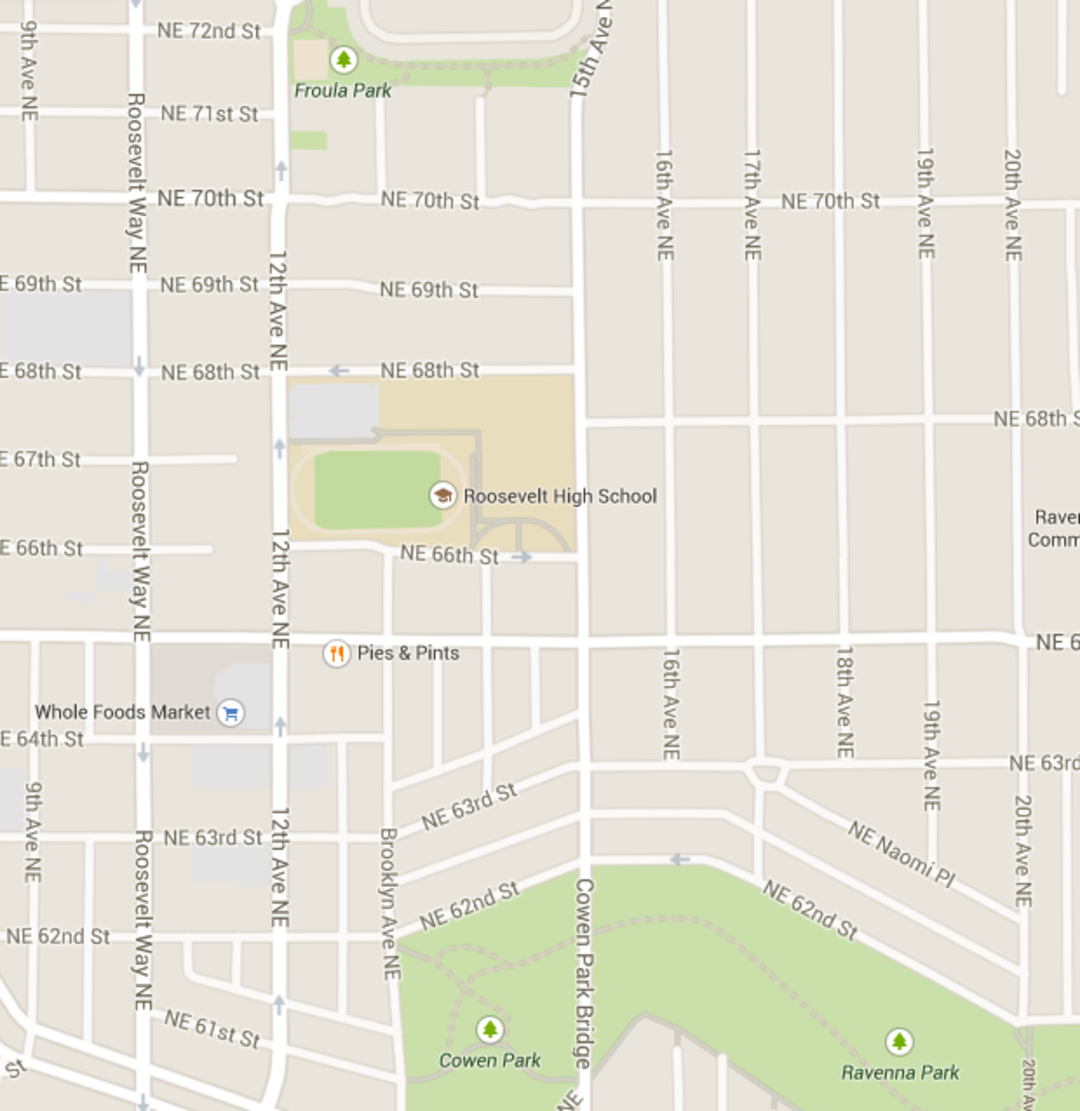More Friday Likes and Dislikes, Plus an Isn't It Weird and a Jolt

Isn't it Weird That
1. Isn't it weird that...at a time when affordable housing is arguably the most pressing issue in the city, the mayor announced today that he's turning housing property into a park. There's nothing wrong with parks, but in a city with limited land that's simultaneously resistant to density, it's a blown opportunity.
The land in question, just north of Northeast 65th St. at 14th Ave. Northeast in Roosevelt, is owned by infamous property owner Hugh Sisley who owes the city around $3 million for housing code violations and related fines on the site. The city attorney, using eminent domain and foreclosure, is basically seizing the property in lieu of the fines and building a park. City attorney Pete Holmes, who's been working on ousting Sisley for the past two years, told me he was "tired of Sisley giving us the middle finger," and with his judgment lien against Sisley Holmes said he asked the parks department if they could use the land. "This is poetic justice," Holmes said.
Sounds good.
But here's a problem. The very block that Sisley's property is on was upzoned in early 2012 from 40 feet to 65 feet in anticipation of the light rail station to accommodate more density. It was a contentious process, but was ultimately a compromise win for city policy makers who are committed to building dense housing around transit lines. The planned light rail station will be at 12th Ave. Northeast and Northeast 65th, just two blocks west of the Sisley property. Oh well, so much for transit oriented development—the zoning just went from 65 feet to zero feet there.
The zoning just went from 65 feet to zero feet.
Asked about the decision to build a park instead of housing, Murray spokesman Viet Shelton told me: "It's about a balanced approach. Part of getting more density is making sure that in addition to more housing that comes with it, you also have additional public amenities."
But you know what else is already near the property? Lots of other parks: Cowen and Ravenna parks are about three blocks south; Froula park is about five block north; and the decomissioned Roosevelt Reservoir, just north of Froula park may be lidded and turned into a park-style amenity, neighbors say.

The park announcement also came as a surprise to some members of the Ravenna-Bryant Community Association, though, the president of the association, Tony Provine, a newly-announced candidate for the fourth council district, was aware that Holmes had a plan. According to Holmes, who, due to his legal scheme "kept it quiet," relied on Provine to let neighbors know a plan was in play.
Transportation Choices Coalition director and fourth district candidate Rob Johnson—whose platform prioritizes housing near transit stations (two blocks away in this case)—wasn't about to criticize a new park. "I'm super excited about finally dealing with this blighted property in the neighborhood," he said. Asked about the lost opportunity for smart urban planning, he said simply: "I like what I'm hearing out of the [mayor's affordable housing task force] about using public land for affordable housing along with other tolls to address affordability such as using the city's bonding capacity and allowing for more accessory dwelling units and backyard cottages."
And Michael Maddux, another candidate, who was at this morning's announcement, said pretty much the same thing: "I am glad that the city, notably Pete Holmes, are working to hold property owners who are not keeping their buildings up to code to task. I also agree with the mayor—it is imperative that our neighborhoods with increasing density have amenities that keep them livable—parks, thriving small businesses, and community centers. I'm interested in hearing more of what the vision of the neighborhood is for what a potential park would look like, as well as how this would impact the current plans for part of the city that's so close to an incoming light rail station. We have an affordability crisis, especially for family-size workforce and subsidized housing, and I look forward to hearing how this property conversion will play into addressing that crisis while maintaining livability."

2. I want to add one more LIKE to this morning's edition of Friday's LIKES & DISLIKES.
I LIKE that Seattle Met senior editor Allecia Vermillion's feature story in this month's magazine, "The Brief, Extraordinary Life of Cody Spafford," was featured on BuzzFeed's list of nine "Feature Stories You Can't Miss This Week," in the number three spot just behind a New Yorker feature. It's also at nearly 17,000 Facebook shares.
Allecia's story, which documents Spafford's tragic demise from rising-star sous chef at the Walrus and the Carpenter into a desperate bank robber who the police shot and killed in a wild standoff, was also the top pick of the week from the prestigious Longreads blog.
Allecia's must-read (all 5,000 words) story beings:
THE SUN HAD SET on Thursday, April 3, 2014, by the time Renee Erickson stepped onto the patio behind the Walrus and the Carpenter in search of news. It was still too cold to seat diners outside, and she needed a moment of solitude and a chance to check her phone. Nobody had heard from her sous chef, Cody Spafford, since the night before. Worries had turned into rumors. Rumors gave way to alarm. The entire staff was slightly on edge. Something was wrong. She was sure of it.
She sat down on a bench just as her business partner, Jeremy Price, called. “Cody’s dead,” he said. “And it’s worse than that.”
Everything around Erickson blurred as she processed Price’s words. She composed herself just enough to walk back inside, tell her employees, and shut down one of Seattle’s busiest restaurants in the middle of dinner service. Price arrived and posted a sign on the front door while the staff called their way down the hour-long wait list.
The revelation that her sous chef had died was devastating, but seeing the photos that police released the next day was almost worse. The guy whose goofy grin was such a fixture at the restaurant, who eased the sting of a chaotic shift with his signature dance, a gyration similar to the Carlton from The Fresh Prince of Bel-Air, but more rubbery of limb—in what universe could he be the same person bank security cameras recorded pointing a gun at the teller? His appearance in the photo that circulated on TV and on news sites all over the city was the most unbelievable thing of all: the shoulder-length wig, the thick layer of white stage makeup, and the fake nose transforming his face into a nightmare.

Afternoon Jolt
3. And finally, an Afternoon Jolt, though this one doesn't come as much of a surprise: Longtime Seattle City Light director Jorge Carrasco offered his resignation to the mayor earlier this week and announced his retirment today effective May 8.
Seattle City Light's chief compliance officer Jim Baggs will be the interim director while the mayor's office does a national search.
Carrasco, who's been head of Seattle City Light since 2004, has faced a series of mini-scandals, mishaps, and oppostion in the last year. And today's announcment feels like resigned conclusion to what has been inevtiable for months.
Carrasco got into hot water in June for using a public relations company called Brand.com that specializes in manicuring and scrubbing online press. That scandal blew up in the middle of his quest for up to $120,000 raise—which put Carrasco, who was already the highest paid city employee at $245,000, on the hotseat with council member Kshama Sawant.
The council did approve a raise, but Mayor Murray put the kibosh on it when the Brand.com mishap blew up—and was compounded by Carrasco's inaccurate claim to the press that he hadn't actually asked for the raise, but that Murray had offered it. (There was also an embarrassing story about scam artists who tricked Carrasco into donating city light copper wire to a fake charity.)
